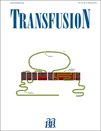Risk factors and outcome associated with hypomagnesemia in massive transfusion
This study was funded solely by the Department of Intensive Care Medicine, Royal Perth Hospital.
Authors' contribution: KMH initiated the idea of the study, confirmed the accuracy of the data, analyzed the data, and drafted the manuscript. AL interpreted the data and drafted the manuscript. Both authors approved the final version of the manuscript.
Abstract
BACKGROUND: Electrolyte disturbances are common in patients with critical bleeding requiring massive transfusion. The risk factors and outcome associated with the occurrence of hypomagnesemia in massive transfusion remain uncertain.
STUDY DESIGN AND METHODS: A cohort of 353 consecutive patients who required massive transfusion, defined as 10 or more units of allogeneic red blood cells or whole blood transfusion within 24 hours, between 2002 and 2008 in a quaternary health care center in Western Australia was considered. Logistic regression was used to identify risk factors and outcome associated with hypomagnesemia during massive transfusion (<0.7 mmol/L or 1.7 mg/dL).
RESULTS: Of the 353 patients requiring massive transfusion during the study period, 298 patients (84%) had serum magnesium concentrations available for analysis. Hypomagnesemia was common (172 patients, 58%), and the mean magnesium concentration was 0.68 mmol/L (1.65 mg/dL; standard deviation, 0.15 mmol/L) in these patients. The risk factors for hypomagnesemia were hypocalcemia (odds ratio [OR], 1.67 per 0.1 mmol/L decrement; 95% confidence interval [CI], 1.36-2.01; p = 0.001) and hypofibrinogenemia (OR, 1.05 per 0.1 g/L decrement; 95% CI, 1.01-1.09; p = 0.009). The lowest serum magnesium concentrations were associated with the lowest ionized calcium concentrations (Spearman correlation coefficient, 0.377; p = 0.001). Both magnesium concentrations (OR, 0.91 per 0.1 mmol/L increment; 95% CI 0.31-2.69; p = 0.863) and the interaction term between magnesium and calcium concentrations were not associated with an increased risk of mortality after adjusting for other covariates.
CONCLUSIONS: Hypomagnesemia was common and associated with hypocalcemia in massive transfusion, but serum magnesium concentrations had no independent effect or interactive effect with hypocalcemia on mortality of patients requiring massive transfusion.




